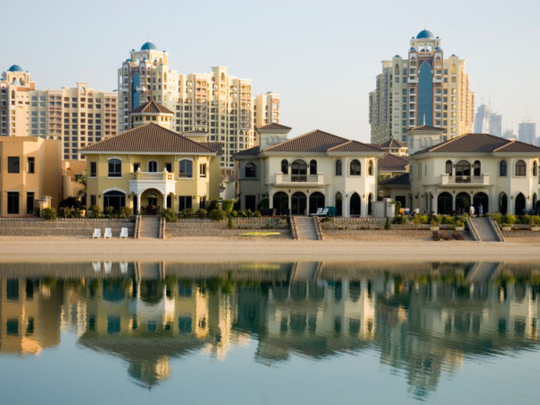
As we move into the second quarter, the short-term prospects of the Dubai residential market appear subdued. The rental market’s fortunes remain tied to the looming World Expo 2020. At this stage, construction contracts worth Dh11 billion linked to the Expo are expected to be announced throughout the year, which will drive up the rate of job creation. New jobs that follow are likely to be centred on low- to middle-income groups, which is likely to boost competition for more affordable stock.
Top remains weak
For now, of the 32 freehold submarkets we track across the emirate, 12 have registered price declines in the first three months. The Burj Khalifa (down 6.9 per cent) led the residential capital value declines during the first quarter as the appetite for luxury, high-end property remains weak. With this latest change, average residential values in the Burj Khalifa are 25 per cent down on this time last year, positioning it as the weakest performer across the city, although values here, which stand at roughly Dh2,700 per square foot, are still among the highest in the city.
Hattan Villas at The Lakes (down 13.5 per cent), Hattan Villas at Arabian Ranches (down 12.6 per cent), villas on the Palm Jumeirah (down 12.3 per cent) and apartments on the Palm Jumeirah ( down 11 per cent) rounded off the list of the five weakest-performing markets over the past 12 months.
Similarly, in the rental market, it has been at the very top end of the rental spectrum where prices have been squeezed the most. High-end villas on the Palm Jumeirah, Jumeirah Islands, Hattan Villas at The Lakes and Hattan Villas at Arabian Ranches have collectively seen average rents slip by nearly 20 per cent over the past 12 months. This compares to an average decline of 9.9 per cent across the rest of the city.
These residential submarkets, particularly the villa sectors, are among the most expensive in Dubai. Their presence on the list of the most underperforming areas in the city reflects the continued buyer focus on areas perceived to offer the greatest value for money.
The aversion to high-end homes stems from underlying affordability issues and perhaps, more importantly, nervousness borne out of uncertainty surrounding the health of the global economy in the wake of recent events, including Britain’s historic decision to leave the EU, persistent weakness in oil prices, the election of Donald Trump and the unknown impact the new US President’s policies may have on global economic growth.
Lifestyle, affordability central to price resilience
Victory Heights (Dh1,125 per square foot), Arabian Ranches (Dh1,115) and Emaar developments in Downtown Dubai (Dh2,100) appear to have bucked this trend, with prices holding steady over the past 12 months. Clearly, the perception of good value and the entrenchment of existing communities have aided these markets’ stability. Although it is worth noting that over the past three years, values at Victory Heights and Arabian Ranches have declined by 19.1 per cent and 10.3 per cent respectively, suggesting these markets may be approaching their lowest ebb.
Aside from the Burj Khalifa, the lifestyle and destination living appeal of Downtown Dubai has in a way insulated the market’s performance from the fall-out of global geopolitical events, which has also spurred development activity and new project launches in the past 12 months. However, the number of plots available inside the Mohammad Bin Rashid loop are very limited, which will start to create a supply bottleneck in this area, suggesting that the resilience in values in Downtown Dubai, excluding the Burj Khalifa, will persist as purchase opportunities diminish. In fact, there was a 47 per cent drop in the number of units launched in Downtown last year, when compared to 2015.
Off-plan still buoyant
Interestingly, the off-plan market continues to be active and was responsible for 53 per cent of all transactions last year, according to Reidin. The banking liquidity crunch in the aftermath of the oil price collapse two years ago appears to have subsided to a degree, which has supported the steady performance of off-plan homes. We anticipate the off-plan market to remain upbeat, especially for schemes launched by reputable developers in and around established communities such as Dubai Marina or Downtown Dubai.
Stability by year end
Any benefit from the World Expo on the sales market is likely to lag the rental market, however, the performance of residential capital values is intrinsically linked to the wider regional and global macroeconomic picture. The former is especially important given the crucial role of regional investment in Dubai’s property market landscape.
Ahead of any Expo-linked boost to demand, the sales market is expected to register further corrections of up to 5 per cent on average, with the top end of the secondary market likely to be impacted more severely. Anything priced in excess of Dh1,800-Dh2,000 per square foot is likely to be slow to sell. There is, however, potential for increased stability towards the end of the year.
| Weak at the top |
|---|
| Burj Khalifa |
| Hattan Villas at The Lakes |
| Hattan Villas at Arabian Ranches |
| Villas on the Palm Jumeirah |
| Apartments on the Palm Jumeirah |
| Holding steady |
|---|
| Victory Heights |
| Arabian Ranches |
| Emaar developments in Downtown Dubai |











